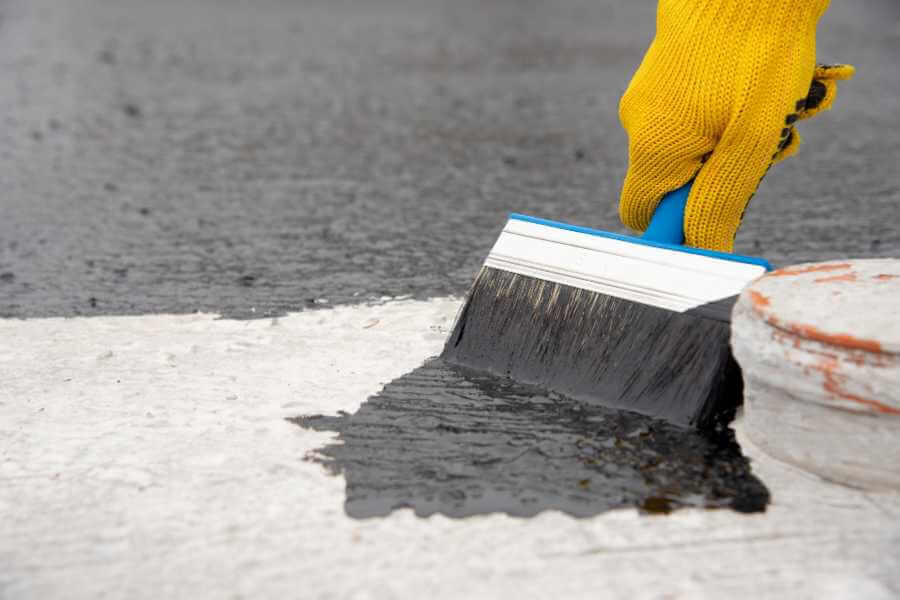Waterproofing is a critical task of construction projects, which prevents water and moisture infiltration in concrete structures. It can significantly decrease maintenance costs associated and ensure structural longevity and durability when well executed.
Among the various waterproofing solutions available, liquid waterproofing membranes have gained popularity for their versatility and ease of application. But what are they exactly?
Liquid waterproofing membranes are polymer-based coatings applied in liquid form on surfaces, such as roofs, walls and basements, to create a physical barrier against water. They offer long-lasting protection from moisture intrusion in a cost-effective manner.
In this blog post, we will explore these membranes further and the existing options, their benefits, and when to use them for optimal results.
What is a Liquid Waterproofing Membrane?
Liquid waterproofing membranes, also known as liquid applied membranes (LAM), are a versatile and seamless solution used in construction to protect against water infiltration, as their name states.
When correctly applied, they adhere firmly to the substrate and can accommodate structural movements without compromising waterproofing features. These membranes can be made of different material types, such as polyurethane, acrylic, cementitious, and bituminous, each suited for specific applications (more on each material below), and are known for their ease of use.
One of the main advantages of these waterproofing coatings is their “joint-free” feature, significantly reducing the risk of water seepage compared to other methods, such as waterproof sheets.
Some contractors also prefer this approach, given their ability to cover working larger areas at once and increased service productivity. There are multiple options available in the market, such as liquid rubber, which is water-based, and contains no solvents, VOC (Volatile Organic Compounds) or harmful odours.
Are Liquid Waterproofing Membranes efficient?
Absolutely! Liquid waterproofing membranes offer numerous advantages that make them an excellent choice for waterproofing needs.
Some of the main features of these membranes are:
- Seamless Application: Liquid waterproofing membranes are applied in liquid form, allowing for a continuous coating and eliminating the need for joints and seams (common weak points in traditional waterproofing systems).
- Flexibility and High UV resistance: These membranes are highly flexible and can conform to any surface shape or contour. This characteristic makes them suitable for various applications, including flat and irregular surfaces, without compromising their waterproofing effectiveness, even with long sun exposure, given their high UV resistance.
- Versatility: Liquid waterproofing membranes can be used on various surfaces, including roofs, walls, balconies, terraces, and even complex structures like bridges. Their versatility allows for effective waterproofing in diverse construction projects.
- Compatibility with Various Substrates: These membranes are compatible with different substrates, such as concrete, metal, wood, and existing membranes, making them suitable for various construction materials and scenarios.
- Excellent Adhesion: Liquid waterproofing membranes adhere firmly to the substrate, forming a robust bond with the surface they are applied to. This adhesion ensures that the membrane remains in place despite structural movements and prevents water from seeping through gaps.
- Ease of Application: These membranes can be applied using different methods, such as spraying, brushing, or rolling. This ease of application not only saves time but also allows for efficient coverage of challenging or hard-to-reach areas.
- Quick Curing: Liquid waterproofing membranes often have a relatively quick curing time, which means that the surface can be ready for use or additional construction shortly after application.

What are the Existing Types of Liquid Waterproofing Membranes? (And When to Use each)
Liquid waterproofing membranes are available in various types, each with unique properties and suitable applications.
The table below summarises the most common types of liquid waterproofing membranes, a brief description of their characteristics, and indicative guidance for each should be applied in a construction project.
Type | Description / Features | Commonly Used for | Why use them? |
Polymers (Polyurethane, Hybrid Polymers) | Highly elastic with excellent UV resistance. Provides seamless and durable waterproofing. |
| Ideal for areas exposed to weather, foot traffic, and UV rays. Offers flexible and long-lasting protection. |
Acrylic | Cost-effective and easy to apply. Offers decent water resistance. |
| Suitable for internal applications where budget constraints exist, and exposure to external elements is minimal (can also be used on concrete pavers) |
Cementitious | Combines cement and acrylic polymers for enhanced durability and adhesion to concrete surfaces. Can withstand hydrostatic pressure. |
| Excellent for areas prone to water containment and hydrostatic pressure, such as water tanks and swimming pools. |
Bituminous | Based on bitumen, providing excellent waterproofing for below-grade structures. Resistant to water and dampness. |
| Ideal for below-ground applications, protecting against groundwater seepage and moisture intrusion. |
Liquid Waterproofing Membrane - Best Options
We have handpicked some options to help you choose the most suitable choice for your project. However, we remind you that each project is unique, and you should consider all the aspects, such as project needs, budget and environmental conditions.
Best Liquid Waterproofing Membrane for foundations and basement
Liquid Rubber Concrete Foundation and Basement Sealant is easy to apply (no need for breathing apparatus) and is highly flexible, which can easily accommodate foundation and basement moves caused by soil settlement.
Best Liquid Waterproofing Membrane for Concrete and Stone Surfaces
The Armor AR350 is a solvent based acrylic wet look sealer that is designed to seal, enhance, and protect a variety of interior and exterior concrete and stone paver surfaces.
It creates a long lasting, non-yellowing, breathable finish that enhances dull or faded surfaces by creating a darkened wet look, and low gloss finish.
Best Liquid Waterproofing Membrane for Roofs
Liquid Rubber developed a specific product for flat and sloped roof. It is compatible with Concrete, Metal, Wood, EDPM, and PVC, and comes with a HIGH UV RESISTANCE AND INCREASED FLEXIBILITY, which will significantly decrease the risks associated with cracking.
Best Liquid Waterproofing Membrane - Overall Use at Small Scale
Gorilla Patchers are ideal for small works and repairs, which will not require significant amount of coating, such as small roof leaks, PVC pipe joints, windows, etc. To facilitate use, it comes in liquid, paste and spray forms, which are very easy to work with.
What are the alternatives to Liquid Waterproofing Membrane?
Liquid waterproofing membranes are not the only option to protect structures from water infiltration and seepage. Other alternatives that can be considered for your project are:
- Sheet Membranes: Pre-manufactured membranes made from bitumen, PVC, or EPDM materials. They offer excellent puncture resistance and are relatively easy to install, providing reliable protection against water intrusion.
- Cementitious Coatings: Portland cement-based coatings that can be applied to surfaces as a slurry. They are commonly used for positive and negative side waterproofing, providing a durable barrier against moisture.
- Bentonite Waterproofing: Utilizes the swelling properties of bentonite clay to create a self-sealing barrier against water. It is often used in below-grade applications and can be effective in certain conditions.
- Crystalline Waterproofing: Applied as a coating or admixture, crystalline waterproofing reacts with water to form insoluble crystals, filling and sealing pores in concrete to prevent water penetration.
- Water Repellent Sealers: These sealers are designed to penetrate and protect porous surfaces, reducing water absorption while allowing the substrate to breathe.
- Thermoplastic Polyolefin (TPO) Membranes: Used primarily for roofing applications, TPO membranes offer excellent UV resistance and energy-efficient properties.
- Rubberized Asphalt: A combination of asphalt and rubber polymers, providing a flexible and long-lasting waterproofing solution for various surfaces.
FAQ
Which Liquid Waterproofing Membrane Is the Best?
The best liquid waterproofing membrane depends on the specific application and surface.
Polyurethane and hybrid polymer liquid membranes are popular for flat roofs and high-traffic areas, while acrylic liquid membranes are more budget-friendly and suitable for internal use.
Liquid Waterproofing Membrane vs Sheet Membranes - What is the Best?
The best choice between the two depends on factors such as surface type, project complexity, budget, and applicator expertise. The table below highlights the advantages and disadvantages of each approach.
|
Type |
Pros |
Cons |
|
Liquid Membrane Waterproofing |
|
|
|
Sheet Membrane |
|
|
.
Combining both methods may offer the most effective waterproofing solution, leveraging their strengths where most beneficial.
What Is the Best Liquid Waterproofing Membrane for Roofs?
We recommend considering membranes with high UV resistance and flexibility for roofs, given their exposure to sunlight and temperature gradients that can lead to moves.
Can You Apply New Waterproofing Membrane on an Old Membrane Layer?
In some cases, applying a new liquid waterproofing membrane over an old layer can be done if the existing coating is in good condition. However, proper surface preparation and adhesion testing are crucial to ensure the effectiveness of the new waterproofing system.
We recommend removing the existing coating and applying a brand-new waterproofing layer if in doubt.
Conclusion
Liquid waterproofing membranes offer a versatile and efficient solution to protect structures from water infiltration. However, it is essential to pick the most adequate option for your project, and many factors should be considered, such as:
- Budget
- Environmental Conditions (i.e. sun exposure)
- Area/Structure to be waterproofed
- Curing time
We hope this article was helpful, and if you have any doubts, please do not hesitate to comment below.













